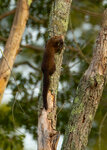


They are resident in our local forests, but even the most devoted nature lovers are rarely rewarded with a sighting. I’ve been hoping to spot one for almost 30 years, and the closest I’ve come was finding a single victim of roadkill along Southern Ave. Of course, I’ve heard them in the dead of night ... or thought I had. What one observer called “an eerie, gruesome cry” and another compared to a “woman’s scream,” may or may not have been fishers. Turns out they are the strong, silent type, rarely making any sound except during mating season in the spring. Those otherworldly sounds we hear in the dark of night more likely come from foxes.
The matter of their vocalizations is not the only misunderstanding about fishers. With apologies to the New Hampshire Fisher Cats minor league baseball team and to many of us who incorrectly use the term “fisher cat,” the fisher is neither a cat nor does it fish. Another misconception is that they are exclusively nocturnal. Not true. They can be active day or night and tend to be especially active during the daylight hours in the winter. They do not hibernate.
Given its elusive nature, I was thrilled to see these fisher photos posted on the Massachusetts Wildlife Facebook page last week by wildlife photographer Paul Malenfant of Ipswich. Paul encountered this fisher not far from Appleton Farms in Hamilton. It was the end of the day and he was about 125 feet from the critter, but his telephoto lens puts us up close and personal. I thank Paul for sharing his photos with me and the Cricket readership. I’ve spent a lot of time looking at photos of fishers and these are the best I’ve ever seen.
The fisher (Martes pennanti) is a member of the mustelid family, which includes wolverines, badgers, weasels, martens, and otters. Adult males can grow up to 40 inches (including the tail) and weigh as much as 15 pounds. They spend most of their time on the ground but are also very agile climbers. Their primary range is in the boreal forests to the north of us and points west.
In the 18th and 19th century, fishers were extirpated from Massachusetts as a result of clear cutting of woodlands and trapping. Ironically, the species’ resurgence was due in part to the logging industry. According to Mass Audubon, “In the 1950s logging companies reintroduced fishers into Northern New England to control porcupines . . . that were decimating seedlings planted by timber companies. The fisher is the only species to deliberately target porcupines as prey.”
While not exclusively carnivorous, fishers feed mainly on birds, small mammals, and carrion. They are particularly adept at raiding the nests of birds and squirrels. Paul Malenfant thinks his fisher was probably feeding on frogs in a swampy area just below the trees where he spotted it. And, as you’ve probably already guessed, fishers will also prey upon house cats and chickens. But they are not as likely as coyotes and foxes to raid residential areas, preferring instead to remain in the relative safety of the forest.
I would be happy to hear from readers about local encounters with fishers. Please post your stories on The Cricket Facebook page or send me an email.